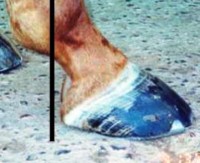
A Horse, of Course with Don Blazer |
If you enjoy learning about horses, then you'll love our online courses. Each month you'll find a new column on our web site. We hope you'll enjoy it, and maybe e-mail us with questions or suggestions for other columns. A Horse, Of Course is a monthly column syndicated by Success Is Easy. If you like the column, call your local newspaper, or local horse publication and ask them to subscribe by contacting Success Is Easy. |
Heel Support - It's Not Rocket Science Don Blazer copyright©2014 |

Never abdicate
the responsibility for your horse’s feet to a farrier or a veterinarian. And do not leave your horse’s foot to the whims of nature. Your horse is not in a natural state. He is not a wild horse. The natural foot of a wild horse is not in the least relevant to your horse. Under-run heels and long toes are the most common hoof problem seen in the domestic horse. Perform this test to determine if you horse's hooves are unbalanced in this manner: Stand at the side of the your horse. Place your thumb on one side of the widest point of the cannon bone and your index finger on the other side. Now gently run your fingers down the cannon bone and onto the fetlock joint. Where your fingers rest in the middle of the fetlock joint should represent the center of the rotation of the fetlock joint. A vertical line dropped directly to the ground from that point should brush the hoof wall heel. If the heel hoof wall touches the ground in front of the line, the horn tubules of the hoof wall have probably been crushed under, and the heel is under run. The heel of this horse's foot is in front of the imaginary line...an unbalanced hoof Next check the balance of the hoof itself: Imagine a line running through the center of the pastern to the coronet band. Put your finger on the coronet band at the point where the imaginary line strikes the coronet. That point is very close to the center of the rotation of the short pastern and the coffin bones. If you drop a vertical line straight down from that point to the ground, the line should bisect equally the weight bearing portions of the foot. It is easy to measure the distance forward to the toe and rearward to the heel at ground surface. The weight of the horse should be centered between the toe and heel. If the distance to the toe is longer than the distance to heel at ground surface, or vice versa, then there is no dorsal/palmar balance. (Dorsal: toward the front; palmar: toward the rear). A lack of dorsal/palmer balance is another frequent hoof imbalance issue and is almost always the result of poor shoeing practices. The shoer applies a shoe which is too small to provide palmar distance for balance and is inadequate to protect the hoof capsule at the heels. If the weight bearing portion of the hoof, or the horse shoe does not extend as far behind the weight of the horse as the toe extends in front, then everything collapses backward, creating the under run heel. A shoe too short to provide adequate dorsal/palmar balance is generally used because it requires little shaping and there is very little chance the horse will catch it with a hind foot and pull it off. Horse shoers do not like to make their clients unhappy by having shoes come off, and horse shoers do not like return trips to replace lost shoes because such trips reduce their profit margin. Horse shoers generally do not trim the foot adequately (especially the toe) because they do not want to risk the horse being a bit “ouchy.” It’s very unfortunate for horses that from a business viewpoint it is better to have an unbalanced hoof than an unhappy horse owner. I am not suggesting that a horse should be “ouchy” just after being shod. It is a fact, however, that freshly exposed horn can be a bit sensitive. When a foot is left “just a little long” each time to avoid the possibility of tenderness, the foot eventually gets “much too long”, and is then out of balance. The following picture shows the hoof in the previous pictures, after corrective shoeing was implemented. A shoe was put on in the reversed manner. This allows the toe to be worn off naturally, and the "toe" of the shoe (now at the heel) provides heel support. The following pictures are of a mare who had low heels and long toes. She was shod with a reversed shoe. The pictures are after five weeks of wearing the reversed shoe...her toe is becoming shorter and she has heel support. The "fix" is easy, inexpensive and usually does not cause the soreness in the horse. This mare has other problems, as indicated in the rotten hoof wall and uneven coronet band...but that is another article! * For information about balancing the hoof take the online course "Bits, Saddle Fitting and Hoof Balance", written by the late Don Blazer, and taught by Cherie Vonada. Earn a certificate of completion from the Equine Studies Institute www.equinestudiesinstitute.com |



